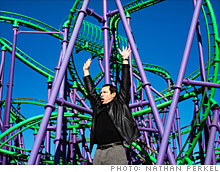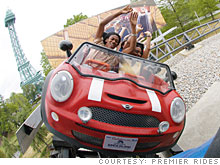A roller-coaster business - literally
How a thrill ride manufacturer stays on the rails.
 |
| Jim Seay, president of Premier Rides, in front of one of his company's creations: Joker's Jinx, at Six Flags Theme Park in Maryland. |
 |
| Premier's innovative rides include the Backlot Stunt Coaster at King's Island, Ohio. |
(Fortune Small Business) -- "Is this a roller coaster?" asks the guy behind me.
It's a reasonable question. In line for a ride called Revenge of the Mummy at Universal Studios Orlando, we're surrounded by the trappings of an Egyptian tomb and flanked by attendants dressed like members of a malevolent cult. Above our heads a bank of screens shows previous riders screaming in terror. The only indication that we are about to get on a roller coaster is a sign warning us that we will undergo "sudden and dramatic acceleration, tilting, dropping and backward motion."
Welcome to the world of Premier Rides, the company that designed Revenge of the Mummy and around 30 other major theme park attractions, each of which has about a million riders a year. The titans of the $11.5 billion U.S. theme park industry, including Universal and Disney (DIS, Fortune 500), are locked in a battle for market share. That struggle has made Premier, based in Millersville, Md., the busiest designer of steel roller coasters in the country, with 40 employees and $80 million in annual revenue.
Premier has mastered technology that allows it to keep dreaming up ever more thrilling thrill rides. "Guests are very sophisticated these days," says Premier president Jim Seay, 48. "Their level of expectation is very high."
They expect thrills, of course, but they also demand safety. If Premier screws up a product, as it has in the past, the results could be disastrous.
Compared with its clients and rivals, Premier is relatively new to the roller-coaster scene. The company was founded in 1994 by Peter Schnabel, who was then running North American operations for Intamin AG, the Swiss roller-coaster giant that controls a quarter of the global market.
Striking out on his own, Schnabel courted Seay, who was a promising young amusement park executive in charge of developing new rides for Six Flags. Schnabel booked him a first-class ticket to Maryland and then took him on a flight over Chesapeake Bay in a Navy T-34 trainer. "If you join Premier, we can go flying every day," Schnabel told Seay.
It was an offer Seay couldn't refuse. In his spare time he surfs, rides ATVs and flies his own plane.
"I didn't even ask him what the salary was," Seay says. "I said, 'Oh, okay,' and that was that." A year later, Schnabel became seriously ill with cancer and sold the company to Seay, who remains the sole owner. (Schnabel, who subsequently recovered, is now an executive vice president.)
From the beginning, Schnabel and Seay understood the key to success in roller coasters. Every new attraction must offer something unique. Take a recently opened Premier roller coaster, Maximum RPM. It shunts cars into a wheel-shaped elevator, which rotates as it lifts the cars to a higher section of the track. When the cars roll off the elevator, the passengers can't see the track ahead of them - so it feels as if they are about to tumble into space.
"Premier is very innovative," says Bill Linkenheimer, secretary of American Coaster Enthusiasts, a fan club for amusement park riders. "It's the go-to company for parks that want to build something customized. Its people are willing to do anything."
Premier can push the envelope because of a propulsion system called the linear induction motor (LIM), which the company developed jointly with Paramount Parks. A LIM consists of computer-controlled electromagnets that power up one after another. The magnetic force pulls on metal fins mounted on the cars to accelerate them.
"It's the ultimate clean technology," says Ben Lovelace, an engineer and project director at Premier. "Other than the wheels of the coaster, there are no moving parts."
On a traditional roller coaster, the cars are hauled to the top of the first hill, and gravity does the rest. But a LIM can pump energy into the system at any point. The Revenge of the Mummy ride accelerates suddenly up a steep ramp, which would be impossible on a gravity-based coaster.
Each ride takes several years to design and build, and costs range from $5 million to $20 million - about as much as an independent feature film. Indeed, designing a new ride is a lot like scripting a movie. For the Revenge of the Mummy ride, Universal drew up a detailed storyboard with a seven-act structure that included renderings of the characters and scenes. At one point the storyboard called for the coaster to back up abruptly and spin 180 degrees. Premier's job was to figure out how to make it work.
"They come up with the idea," Seay says. "We come up with the technology to meet the vision."
Once the details are hammered out, Premier outsources construction. One contractor makes the steel track while another builds the cars. By keeping only the designers and engineers in-house, Premier is able to run a lean operation with maximum flexibility.
But a single weak link in the outsourcing chain can wreak havoc. In 1996, several LIM magnet housings cracked on a Premier ride called Mr. Freeze, at Six Flags Over Texas. "One of our suppliers decided to save some money," Seay says.
The flaw was discovered in the course of routine maintenance. As a result, four of Premier's LIM rides had to be shut down. It took nine months to replace all the faulty components. Premier was not sued, nor did it sue its supplier. Seay says such problems are integral to a business where nearly every product is a prototype. Relatively few rides are replicated.
Despite the severity of the problem with Mr. Freeze, Premier demonstrated that it had the resources and the commitment to meet its obligations. "Building a ride is important, but so is sticking around afterward to provide spare parts and follow-on service," says amusement park consultant Jerry Aldrich. "Premier has done a good job of staying with people all the way."
Not all of Premier's clients have met those standards. In 2007 Premier debuted an innovative ride at Hard Rock Park in Myrtle Beach, S.C. that allowed riders to douse one another with water cannons. But the park struggled with cash flow problems from the start and filed for Chapter 11 protection five months after it opened. Premier had already been paid enough to recoup its costs, but it did not profit from the project.
Roller-coaster history is filled with tales of thriving builders who hit a rough patch and went under. Arrow Dynamics, once one of Premier's chief competitors, filed for bankruptcy in 2001 after it developed a ride at Six Flags Magic Mountain that wound up costing more than the company charged. Giovanola, another Swiss rival, went belly-up in 2004 when it spent too much on a ride at Six Flags Over Texas.
Seay seems to have learned from his competitors' mishaps.
"A company needs financial discipline to be successful," he says. "We pride ourselves on having no debt, cash on hand and a significant line of credit."
It helps that the recession shows no signs of slowing the industry. "When you've got money, you go abroad on vacation," says Premier CFO Randy Schmidt. "When times are tight, you go somewhere like Busch Gardens."
Remarkably, 2009 is shaping up to be the strongest year in Premier's history. It has landed its biggest contract ever: It will build a 300-foot-high Ferris wheel at a new entertainment center called Xanadu in East Rutherford, N.J. The Pepsi Globe Observation Wheel, which the beverage company is paying $100 million a year to sponsor for 10 years, will be the tallest Ferris wheel in the Americas (the world's largest, in Singapore, is 540 feet tall).
Premier will also be installing one of the world's largest logos for Pepsi (PEP, Fortune 500) on a massive LCD screen on the side of the wheel. Seay won't specify the Ferris wheel budget, saying only that it is "significantly above" his normal ceiling of $20 million.
Back at Revenge of the Mummy, I climb into the front row of seats with project director Lovelace, who managed the ride's construction. We pass through a tunnel filled with animatronic figures and fog.
"On any ride, you get on and everything's fine," Lovelace says. "Then there's an 'oh, s--t!' moment where you feel like, 'I've gone the wrong way.' And then you think you're going to die."
That moment comes seconds later, as a character screams at us to turn back - it's a trap! We turn a corner, and a towering mummy figure bellows that we're doomed. Flames erupt on all sides of the car. It gets more hair-raising from there, in an ever-escalating rat-a-tat of visual effects, fire and sudden plunges into mayhem.
Two minutes after it begins, the ride slides to a halt, and I rise to my feet, shaking. Lovelace hasn't stopped smiling since we got on. I ask if he, like Seay, is an adrenaline junkie.
"Most everyone I know in this business is like that," he says. "You have to find people who are willing to take a chance. They ski, they skydive, or they do other crazy stuff."
"Keeps you sane?" I ask.
"Yeah," he laughs. "Or insane." ![]()
-
The Cheesecake Factory created smaller portions to survive the downturn. Play
-
A breeder of award-winning marijuana seeds is following the money and heading to the U.S. More
-
Most small businesses die within five years, but Amish businesses have a survival rate north of 90%. More
-
The 10 most popular franchise brands over the past decade -- and their failure rates. More
-
These firms are the last left in America making iconic products now in their twilight. More









